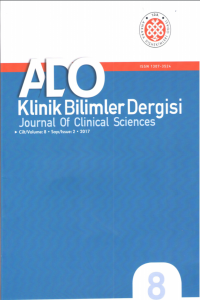Okluzal Düzlem Oryantasyon Bozukluğunun Düzeltilmesi
Okluzyon dikey boyutu, dişler maksimum interküspidasyon durumundayken maksilla ve mandibula üzerinde belirlenen iki referans nokta arasındaki mesafe olarak tanımlanır. Diş aşınmaları, migrasyonları veya posterior diş kayıplarına bağlı olarak okluzyon dikey boyutunda değişimler gözlenebilir. Bazı olgularda nöromusküler sistemin dentoalveoler kompleks değişimlerine adaptasyon göstermesi sonucunda herhangi bir değişim belirlenmez. Böyle durumlarda restorasyon materyaline yer kazanmak ve doğru okluzal düzlem oryantasyonunu sağlamak amacıyla okluzyon dikey boyutunun artırılması gerekebilir. Okluzyon dikey boyutunun değiştirilmesi kas aktivitesinde artış, temporomandibuler eklem üzerinde kuvvet yoğunluğu ve ağrı konusunda endişeler yaratabilir. Dentoalveoler kompanzasyon gözlenen hastalarda stabilizasyon splinti ve/veya geçici restorasyonlar ile okluzyon dikey boyutundaki artışın tolere edilip edilemeyeceği değerlendirilebilir
Anahtar Kelimeler:
Okluzyon dikey boyutu, Okluzal düzlem oryantasyonu
Treatment of Occlusal Plane Disorientation
Vertical dimension of occlusion is defined as the distance between two refence points determined on maxilla and mandible when the teeth are in maximum intercuspidation. Changes in the vertical dimension of occlusion could be observed because of dental wear, teeth migration or the loss of posterior teeth. In some cases, any change could be determined related to neuromuscular system can adapt to the changes of the dento-alveolar complex. In such circumstances, vertical dimension of occlusion needs to be increased for gaining space to the restoration material and providing correct occlusal plane orientation. Some of the concerns with altering vertical dimension of occlusion is related to increasing muscle activity, increasing load to the TMJs and resulting pain. In patients with dentoalveolar compansation, increased vertical dimension of occlusion could be evaluated with stabilisation splint and/or temporary restorations whether the patient can tolerate or not
___
- Lucia VO. Modern gnathological concepts. p 272. St Louis, MO: CV Mosby, 1961.
- Carlsson GE, Ingervall B, Kocak G. The effect of increasing vertical dimension on the masticatory system in subjects with natural teeth. J Prosthet Dent. 41:284-289, 1979.
- Lucia VO. Modern gnathological concepts. pp 41- 56. St Louis, MO: CV Mosby, 1961.
- Manns A, Miralles R, Guerrero F. The changes in electrical activity of the postural muscles of the mandible upon varying the vertical dimension. J Prosthet Dent. 45:438-445, 1981.
- Bloom DR, Padayachy JN. Increasing occlusal ver- tical dimension - Why, when and how. Br Dent J. 200:199-203, 2001.
- Stern N, Brayer L. Collapse of the occlusion - aetio- logy, symptomatology and treatment. J Oral Reha- bil. 2:1-19, 1975.
- Olthoff LW, Van Der Glas HW, Van Der Bilt A. Inf- luence of occlusal vertical dimension on the masti- catory performance during chewing with maxillary splints. J Oral Rehabil. 34:560-565, 2007.
- Ibbetson RJ, Setchell DJ. Treatment of the worn dentition. 1. Dent Update. 16:300-302,305-307, 1989.
- Ibbetson RJ Setchell DJ. Treatment of the worn dentition: 2. Dent Update. 16:300-302, 305-307, 1989.
- Rivera-Morales WC Mohl ND. Relationship of occ- lusal vertical dimension to the health of the masti- catory system. J Prosthet Dent. 65:547-553, 1991.
- Hellsing G. Functional adaptation to changes in vertical dimension. J Prosthet Dent. 52:867-870, 1984.
- Carlsson GE, Ingervall B, Kocak G. Effect of incre- asing vertical dimension on the masticatory system in the subjects with natural teeth. J Prosthet Dent. 41:284-289, 1979.
- Dawson P. Functional occlusion: from TMJ to smile design. (chapter 35). St. Louis, MO: Mosby Elsevi- er; 2007.
- Terzioğlu H, Yılmaz B, Ünsal E.Treatment of the partially edentulous patient with worn dentition. Dent Today. 27:148-149, 2008.
- Machado NA, Fonseca RB, Branco CA, Barbosa GA, Fernandes Neto AJ, Soares CJ. Dental wear caused by association between bruxısm and gas- troesophageal reflux dısease: A rehabilitation re- port. J Appl Oral Sci. 15:327-333, 2007.
- ISSN: 1307-3540
- Yayın Aralığı: Yılda 3 Sayı
- Başlangıç: 2006
- Yayıncı: Ankara Diş Hekimleri Odası
Sayıdaki Diğer Makaleler
Bengi ÖZTAŞ, Şebnem KURŞUN, Kıvanç KAMBUROĞLU, Ümit KARAÇAYLI, Tuncer ÖZEN
Sevil Altundağ KAHRAMAN, Kahraman GÜNGÖR
Doğrudan Yöntemle Yapılmış Kompozit Lamina Çalışması
Bilgisayarlı Tomografi Prensipleri ve Uygulamadaki Yenilikler
Çocuklarda Temporal Kemik Pnömatizasyonu
İntraoral İmplant Destekli Çene-Yüz Protezleri
Merve BANKOĞLU, Seçil KARAKOCA
Okluzal Düzlem Oryantasyon Bozukluğunun Düzeltilmesi
Fasiyal Defektlerin Medpor İmplantlarla Rekonstrüksiyonu
Sıdıka Sinem SOYDAN, Firdevs Veziroğlu ŞENEL, Sina UÇKAN
